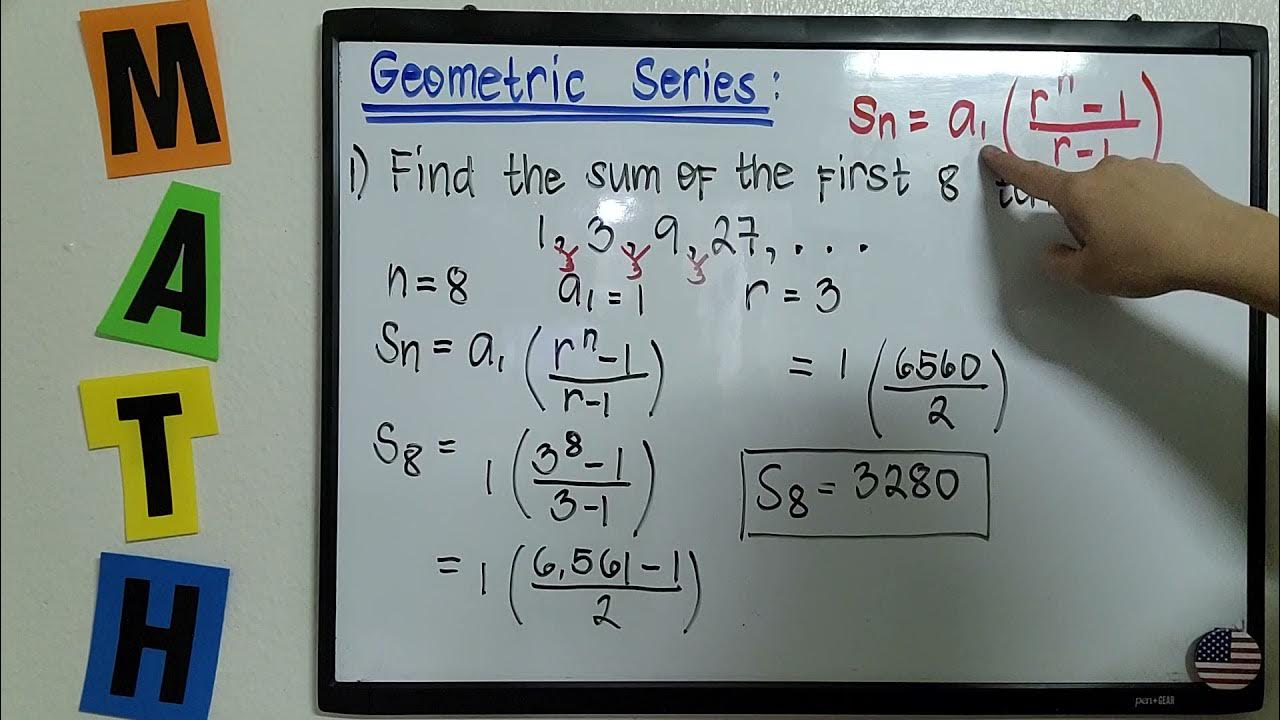Geometric Series | Finding the Sum of Geometric Sequence | Explain in Detailed |
Summary
TLDRIn this video, Teacher MJ introduces geometric series, focusing on finding the sum of a geometric sequence. He demonstrates how to calculate the sum of the first five terms of a sequence manually and by using a formula. Teacher MJ walks through the steps for determining the common ratio and applying the formula, while also showing manual calculations to ensure accuracy. Additionally, he discusses special cases where manual computation is more efficient and challenges viewers to solve a problem themselves. The video offers an engaging math lesson, making complex concepts easier to understand.
Takeaways
- 📐 Geometric series refers to the sum of the terms in a geometric sequence.
- 🧮 Example problem: Find the sum of the first five terms in a sequence like 4, 12, 36, 108.
- ✍️ Manual addition works but is time-consuming, so a formula is preferred: Sₙ = a₁(1 - rⁿ) / (1 - r).
- 🔢 The common ratio (r) is found by dividing the second term by the first term, and similarly for other pairs of terms.
- 🔄 Using the formula, multiplying and simplifying the terms step-by-step gives the sum of the first five terms as 484.
- 🧩 If you calculate manually and compare with the formula, the results will match (e.g., adding terms directly also yields 484).
- ➗ In some cases, like repeating terms or alternating patterns, manual observation can show that the sum is zero without using the formula.
- 📝 When the common ratio is negative, extra care is needed with signs and powers.
- 💡 For sequences like alternating positive and negative terms (e.g., -3, 3, -3, 3), the sum of multiple terms may end up as zero.
- 🔍 For identical terms repeated over multiple terms, you can simply multiply the term by the number of terms to find the sum.
Q & A
What is a geometric series?
-A geometric series refers to the sum of the terms in a geometric sequence, where each term is multiplied by a constant ratio from the previous term.
How do you find the common ratio in a geometric series?
-To find the common ratio, divide the second term by the first term, and then divide the third term by the second term to ensure they are equal.
What is the formula to calculate the sum of a geometric series?
-The formula for the sum of the first n terms of a geometric series is Sₙ = a₁ * (1 - rⁿ) / (1 - r), where a₁ is the first term, r is the common ratio, and n is the number of terms.
How is the sum of the first five terms of the sequence 4, 12, 36, 108 calculated using the formula?
-First, identify the first term a₁ as 4, and the common ratio r as 3. Then apply the formula S₅ = 4 * (1 - 3⁵) / (1 - 3). Calculate 3⁵ = 243 and simplify the equation to get S₅ = 484.
How do you calculate the common ratio in the sequence 4, 12, 36, 108?
-The common ratio is calculated by dividing 12 (the second term) by 4 (the first term), giving 3. To verify, divide 36 by 12, which also gives 3, confirming the common ratio is 3.
What is the common ratio and sum of the first six terms for the sequence 3, -6, 12, -24?
-The common ratio is -2, calculated by dividing the second term (-6) by the first term (3). Using the formula, the sum of the first six terms is -63.
What happens when you multiply a negative number by itself an even number of times?
-Multiplying a negative number by itself an even number of times results in a positive number, as the negative signs cancel each other out.
What is the result when adding the terms in the sequence -3, 3, -3, 3?
-Adding the terms results in zero because each -3 cancels out with a positive 3.
When can you add the terms of a sequence manually without using the formula?
-If the sequence follows a clear pattern, such as repeated pairs of opposite numbers that cancel each other out (like -3, 3, -3, 3), you can add the terms manually without using the formula.
How do you sum eight terms of the sequence 3/4, 3/4, 3/4, 3/4?
-Since all terms are the same (3/4), add them directly. The sum is 3/4 * 8 = 6.
Outlines

This section is available to paid users only. Please upgrade to access this part.
Upgrade NowMindmap

This section is available to paid users only. Please upgrade to access this part.
Upgrade NowKeywords

This section is available to paid users only. Please upgrade to access this part.
Upgrade NowHighlights

This section is available to paid users only. Please upgrade to access this part.
Upgrade NowTranscripts

This section is available to paid users only. Please upgrade to access this part.
Upgrade Now5.0 / 5 (0 votes)





